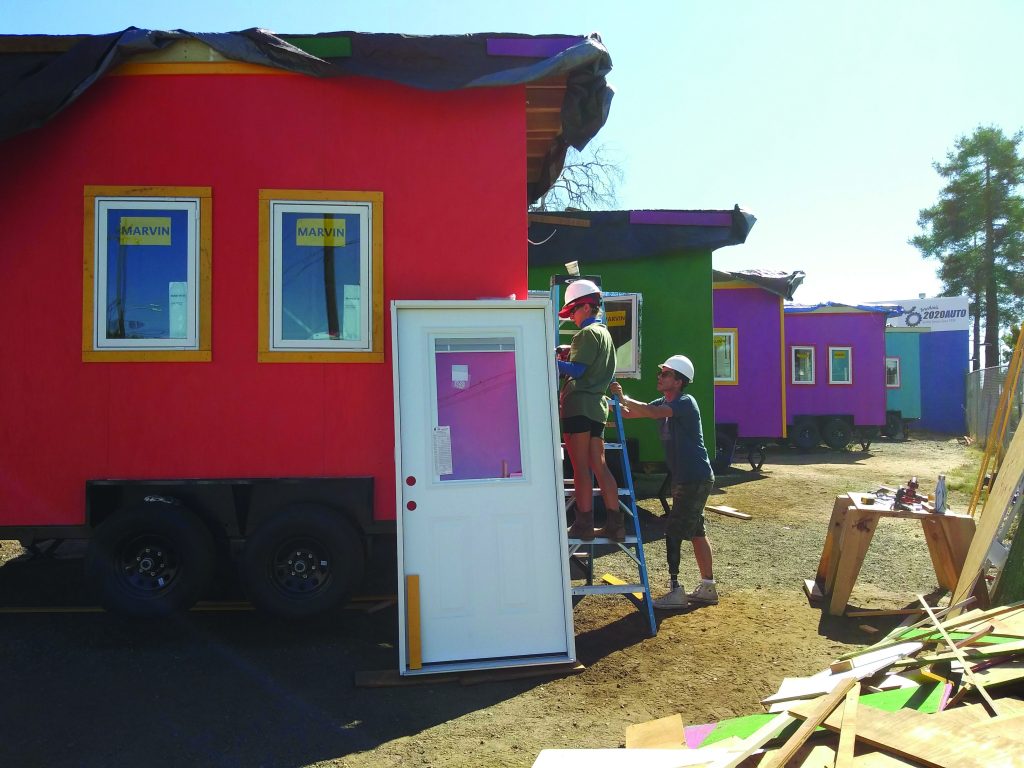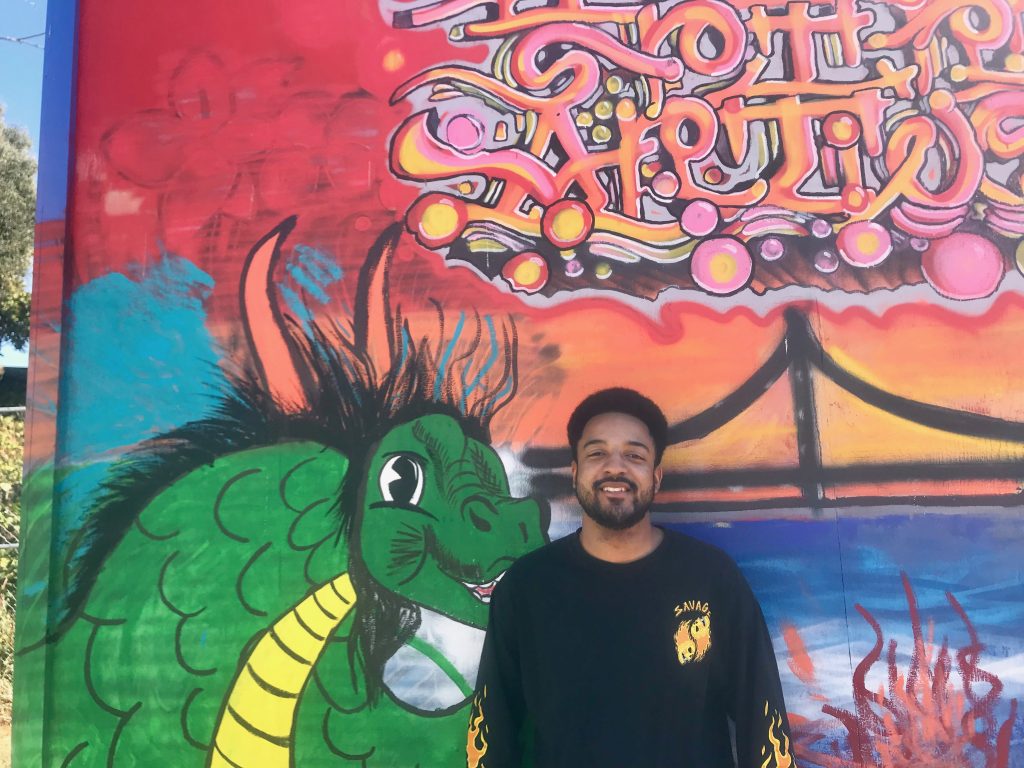
The first thing you notice is the color of the structures. They’re painted vibrant jewel tones: turquoise, fuchsia, candy apple green. Some still lack a front door, but even without them the houses are inviting. They’re spread out across an Oakland dirt lot in various states of built, and resemble a playground. Builders and volunteers buzz around installing doors and windows.
The builders are working an extra Saturday to complete the 12 structures by mid-October. Volunteers from all over the Bay Area have convened in this empty lot as part of the Youth Spirit Artwork (YSA) Tiny Homes Project, which aims to build 100 tiny homes for housing-insecure young people in the East Bay over the next 10 years. (Disclaimer: Youth Spirit artworks is the publisher of Street Spirit.)
YSA is privately sourcing and funding the building effort, and the builders here are all volunteers who have donated their time to put together these structures, ‘Habitat for Humanity’-style.
These 12 are the first push. Mounted on trailers, the homes will be portable rooms for young people ages 18 to 24; spaces where they can sleep, work, and store their belongings. Tiny homes as a solution for homelessness have grown in popularity in cities like Seattle, and now the effort is reaching Oakland where homelesseness has increased by 47 percent in the past two years, according to the 2019 Point-in-Time count.

The bold colors of these homes are just one part of what YSA hopes will make them different from other homeless services in the East Bay.
Reginald Gentry is an assistant project manager and board member for YSA. He said it was important that the tiny homes be a new and different kind of housing project—an alternative to a group shelter, but a step up from the TUFF sheds that Oakland has used to house its homeless. Gentry calls the TUFF sheds “bland” and “boring” and says they don’t seem like homes.
He says once these structures are completed, young artists that are part of YSA will paint murals on them. “So they’ll be looking creative, they’ll pop,” he said. “Once the village is put together in one central location it’s going to be a community”.
Gentry emphasized that community is a core tenet of the project. Once YSA finds a spot for the homes, the organization is hoping to get funding to add a joint kitchen, living room, bathrooms, and an R.A. to supervise, like a college dorm. The first residents will be chosen by YSA and are slated to move in the summer of 2020. Besides building, the community is getting involved in other ways—USF architecture Professor Seth Whatel is working with his class to create the master plan for the village.
Many of the volunteers here have expressed that youth have been overlooked in the conversation about homelessness and housing security, especially those who are entering adulthood.
“People assume ‘oh they’re going straight to college, they’re going to be supported’ but that’s not really the case,” said 17-year old volunteer Itai Timms, a Berkeley resident. Timms says she has friends from Berkeley High School who are currently homeless and living with their friends, or who are going to soon age out of foster care. That’s part of why she’s here.
She says those young people need a place that’s inexpensive and independent that would allow them to stay in the Bay Area if they want.
Jackson Hardemon, one of the program directors, says the objective came from conversations with youth. The project started in 2017 when a few of the youth mentioned that when they leave their shelter program there’s no other place to go. They were feeling forgotten and helpless, so YSA organizers decided to mobilize.
They first looked into using the Ohmega Salvage yard in Berkeley, however Hardemon says the community pushed back against the idea and they moved their sights to Oakland.
“Oakland was a lot more receptive towards this idea,” he said. “Honestly I think it was because we were trying to start something new, something different. It was a new solution for an ongoing problem with youth in Oakland too.”During their most recent budgetary negotiations, the City of Oakland awarded YSA $360,000 to fund the operations of the village, once it is up and running. That money will kick in in July of 2020. This will include the salary for the resident assistants and other staff.
“We’re hoping it becomes a bigger message to pay attention to the younger adults that are still being affected,” said Hardemon, who emphasized that since this effort would be helping youth, it would aim to prevent future homelessness. “They have probably just as many problems as seniors do when it comes to housing security, job security, food security: you name it.”
So far, the Bay Area has answered the call to participate, especially the members of the interfaith community. According to YSA’s Executive Director Sally Hindman, 30 religious communities are involved as volunteers.

One of those volunteers is Mohamad Ashor, who arrived in the Bay Area as a Syrian refugee in 2016. A carpenter for 23 years, Ashor has helped the group install doors. He says he was able to settle in the Bay Area because someone gave him a free one-bedroom apartment to stay in when he arrived in 2016. He’s building because he wants to give the community the same support that he received. Also, he says, he can’t believe the extent of the crisis.
“Sometimes I talk with friends in Syria or Jordan or Saudi Arabia and I tell them ‘look we have people sleeping in the street,’ and they don’t believe me,” he said. “I hope we find houses for everyone who is sleeping in the street.”
The project still faces one big hurdle: finding a site for these 12 homes. Projet leaders are still unsure of where in the East Bay they’ll end up. There are two viable options, according to Hindman. Either Oakland will acknowledge the project as a response to the emergency shelter crisis and lease YSA one of 50 sites slated for affordable housing, or the organization will rent or buy private property from another organization.
Kate Wolffe is a reporter and weekend host at KQED.


